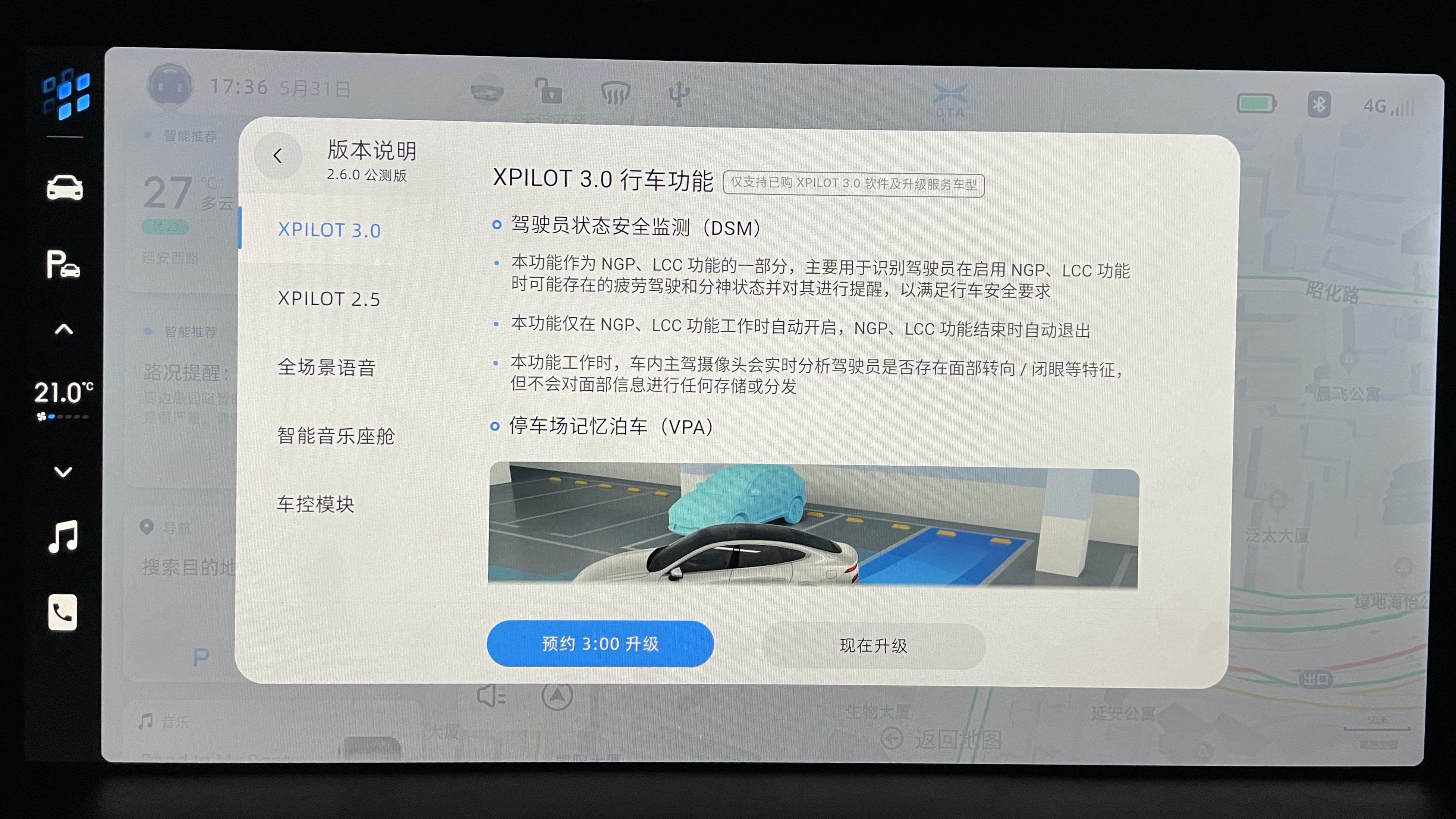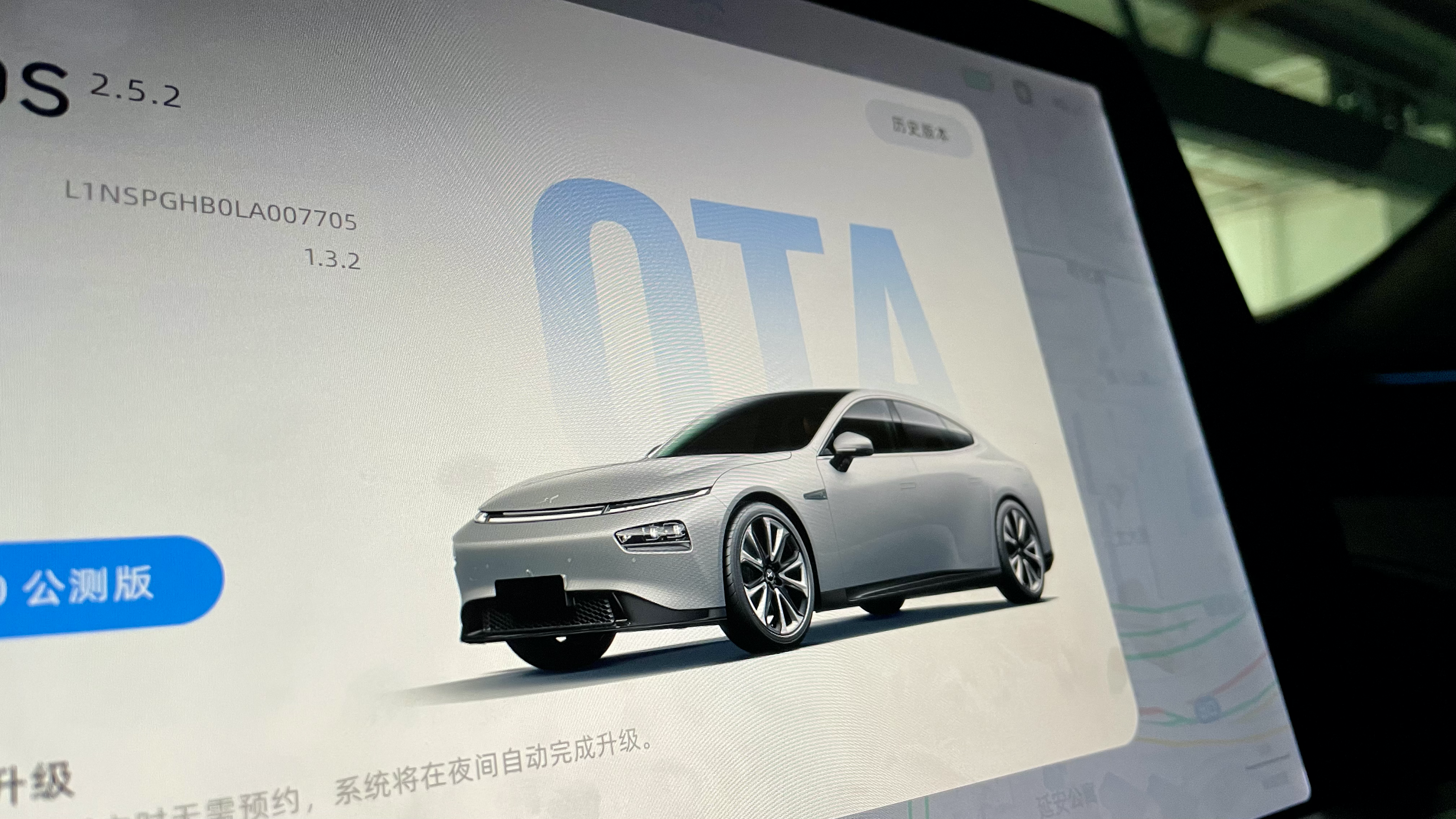Just now, XPeng officially pushed the Smart OS V2.6.0 public beta version software through OTA. As a car owner, every time seeing OTA updates, besides excitement, there is also an indescribable comfort, like the feeling of one’s own child growing up another year.
If we describe XPeng’s OTA history with nine-year compulsory education, this update of version 2.6.0 is like graduating from junior high school to senior high school, which belongs to a historic growth.
6 new features + 13 feature optimizations
In this OTA, XPeng has added a total of 6 new features and optimized 13 details. Because the following analysis will expand on the meaning of several of these features, here is a simple list of all the contents of this OTA. If uninterested, friends can skip to the next part directly.
6 new features
- Driver’s state safety monitoring (DSM)
- Memory parking in parking lot (VPA)
- Intelligent high beam (IHB)
- Voice change lane function added in NGP mode
- Truck warning added in NGP mode
- Automatic recovery function added in NGP mode
13 feature optimizations
- Optimize NGP mode’s deceleration experience when facing cut-in vehicles
- Improve the timeliness of speed limit updates in NGP mode
- Optimize NGP mode’s dashboard display experience in some scenarios
- Optimize NGP mode’s safety in some scenarios
- Optimize ACC’s cornering ability
- Optimize the so-called function of built-in applications
- Youku app supports so-called function
- Optimize the use experience of XPeng music
- Optimize the display content of the dashboard
- Optimize the memory of the air conditioning outlet angle
- Optimize Say HI light language
- Lightsaber mode supports daytime lighting
- Support atmosphere light constant lighting

The most heavyweight point about this update is the addition of memory parking in the parking lot function, which also supports turning, bypassing, avoiding, meeting, and other actions.
But what surprised me even more was the intelligent high beam and voice change lane function.
From a functional point of view, memory parking in the parking lot is indeed a heavyweight function, but this function was already announced at the launch conference of P7 in 2020.
Therefore, this is a function that XPeng planned during the car-making stage. Whether it is hardware or software, the layout was already done in advance. Now its realization is just to fulfill the commitment made years ago and is something that is within expectations.
However, intelligent high beam and voice change lane are completely unexpected. Although many cars have already launched intelligent high beam function earlier than P7, and many people even regard the voice change lane function as a redundant feature.However, it is precisely these functionalities beyond the plan that truly demonstrate a car company’s OTA technical strength.
Unfortunately, at the time of writing, my car has not yet completed this update, so the focus of this article is not on how the OTA’s new added functionalities are experienced this time. Rather, I would like to take this opportunity to chat about how OTA updates are implemented.
Is it that easy to do OTA?
The concept of OTA is not overly explained here – sending an installation package through the network to achieve software iteration update, which is equivalent to the updates of mobile applications or mobile systems.
Applied to cars, some car companies have begun to muddy the waters. Currently, the OTA in the market can be divided into Software OTA (SOTA) and Firmware OTA (FOTA).
The essential difference between the two lies in the system’s ability to schedule hardware.
Supported by SOTA models can only update part of the software in the vehicle, such as commonly used functions on the vehicle’s computer, like navigation and music. It has minimal hardware scheduling capabilities.
One can understand this as placing a smartphone on a regular vehicle, where the software in the phone can implement OTA updates.
And FOTA firmware updates are the real all-in-one OTA, where the central processor can schedule every hardware in the vehicle, such as software updates for the battery management system and drivetrain.
To do a straightforward science popularization, most vehicles on the market are equipped with tens or even hundreds of ECUs, each responsible for different functions, just as every company has different departments, and ECU is like the head of each department, responsible for commanding and managing each employee.
The larger the company, and the more departments mean that the number of managers is also increasing. Similarly, in a car, the more functions, the more the number of ECUs.
To gain more insight into the architectural differences between FOTA and SOTA, I took the opportunity of a media interview to ask Ji Yu, the head of the Xpeng Automotive Internet Center and vice president of Xpeng Automotive, on how to achieve complete vehicle OTA. He believes that “software and hardware” must be combined.
Two points are needed on the hardware side:
First, all ECUs of a car need to have larger storage capacities, at least doubled. For instance, if a car usually only has 4 MB of storage, then to support FOTA, it needs to be 8 MB or even higher.
To ensure the safety and stability of the OTA, there must be A/B partitions during the upgrade process. A partition is responsible for storing the old version of software, while the B partition stores the new software. This ensures that if any new problem arises during an update, the vehicle will revert to the old system while not impairing normal use of functions.
Second, every ECU must be connected to the control center through a CAN bus or Ethernet to enable OTA updates.In addition to hardware capability, software also needs to possess certain abilities.
CAN bus is used to transmit signals in daily operation, and each ECU receives various commands through the CAN bus. For example, when the driver steps on the accelerator pedal, a signal is sent and transmitted through the CAN bus to the relevant components’ ECUs, such as the motor, to achieve acceleration.
However, when upgrading these ECUs, the CAN bus should be silent, because at this time, the CAN bus is transmitting upgrade package data and cannot be used to transmit commands.
Therefore, a car that supports FOTA and a car that only supports SOTA have fundamentally different capabilities. The FOTA capability is born with the car and not supported after it began production.
FOTA = Pre-installed hardware, later fixing?
When NIO just started delivering cars in 2018, many software functions were not yet perfect, but the official continuously improved the product by evolving it through the OTA function.
Therefore, at the beginning of the OTA concept, people were left with the concept that “OTA is just a method to quickly fix the flaws caused by incomplete software engineering of the pre-production period.”
Although I also extremely dislike using OTA in this way, I do not want OTA to carry this “bad” name. Therefore, I also want to provide some knowledge about the value of OTA.
First, the addition of “planned but unplanned” functionalities mentioned above.
Thanks to the underlying connected hardware, the central brain can flexibly schedule different hardware and combine them to create new functionalities.
For example, XPeng P7 is equipped with a microphone, realizing full-scenario voice functionality. At the same time, the external cameras have the ability to brake, steer, and accelerate, achieving driver assistance.
The central processor can receive voice command signals and control the vehicle’s steering, acceleration, and braking systems. By combining these two capabilities with logical commands, the voice control lighting and lane-changing feature has been achieved.
If a car that lacks FOTA capability is operated, each ECU will be independent, just like every department performing the same job every day, and they will not be able to listen to new commands, which greatly wastes the potential of these hardware resources.
Second, OTA helps car companies to find the real direction of development, and will not lag behind due to the rapid development of the industry.
The lifespan of a car lasts between 5-8 years and sometimes up to 15-20 years. Even if the automakers have a strong technical reserve, it is difficult to predict the functionality demand many years later. However, having OTA makes a difference, after all, OTA is free, let’s have a try, and we will eventually find the right path.
When NIO launched the ES8 in 2017, the R&D department did not plan for the NOP navigation assistance function. However, with sufficient hardware, the function is realized through OTA in 2020.2018, during the development stage of the G3, XPeng did not expect to implement the Sentry Mode through sensors such as cameras and radars, as well as the car’s hard drive, but it was achieved through OTA functionality in April 2019.
In 2020, during the COVID-19 pandemic, XPeng combined PTC air conditioning and remote control via mobile phones to achieve high-temperature sterilization.
In 2021, our latest 42Mark testing found that Tesla, NIO, XPeng, and Li Auto have all optimized their driving assistance experience through OTA functionality.
This is the significance of OTA.
Final Words
Recently, NIO, Li Auto, and XPeng have all released major updates in the past month, and the updated content has changed from filling gaps from a year ago to adding new, creative, and customer-driven functionalities. Compared to traditional car companies who are still hesitant about the safety and necessity of OTA, the gap between truly intelligent cars and traditional cars will continue to widen.
This article is a translation by ChatGPT of a Chinese report from 42HOW. If you have any questions about it, please email bd@42how.com.
